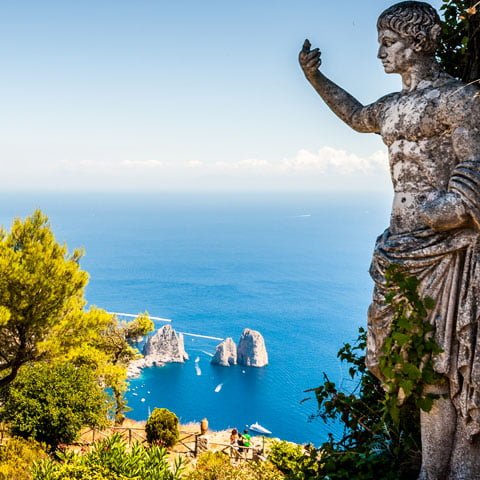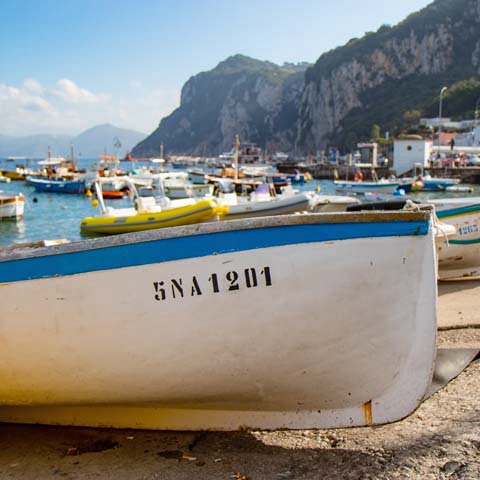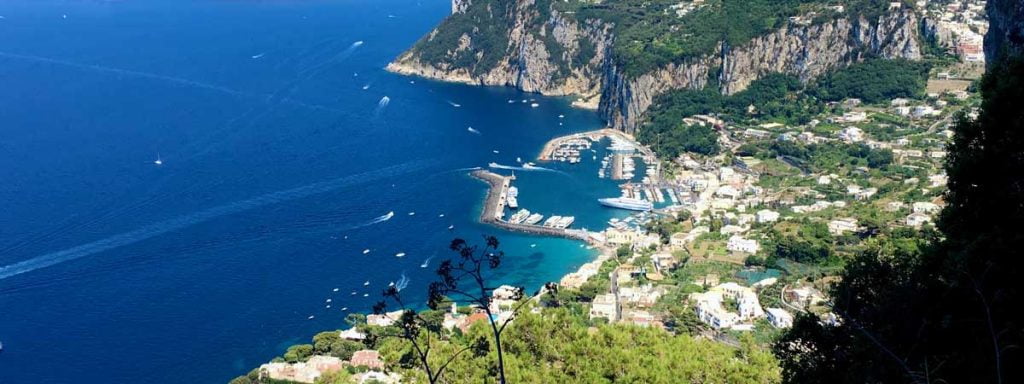Capri is a small Italian island located in the Tyrrhenian Sea. The island is part of the Campanian Archipelago and is located in the southern section of the Gulf of Naples, about three miles west from the Sorrento Peninsula. Capri is administratively divided into two municipalities, Capri and Anacapri, both part of the metropolitan city of Naples.
Composed primarily of non-stratified calcareous dolomites and covered by pyroclastic deposits of local tuff rocks, the morphology of the island was shaped by the surrounding volcanoes and the wind.
The island emerges high on the sea and consists of two plateaus. The western plateau is Anacapri, culminating with the summit of Mount Solaro which rises at 1,932 feet above sea level, constituting the highest point of the island. The eastern plateau is Capri and it culminates with the summit of Mount Tiberio, which rises at 1,095 feet above sea level.
The two plateaus are linked by a central corridor, while the coast is characterized by high, steep cliffs that hide mesmerizing caves.
The signature cave of Capri is the Grotta Azzurra or Blue Grotto, but there are many other interesting grottoes to see in the region.
Stunning monoliths rise from the sea just off the coast of the island called Faraglioni. These fascinating rock formations have become a symbol of Capri.
The area is characterized by a mild Mediterranean climate, with warm and moderately dry winds contributing to the flowering of rich vegetation. The island counts over 800 species of plants, and there is no wonder why the main economic resource of Capri is agriculture.
Citrus, olives, fruits, vegetables and grapes thrive on the island, while the fishing and craftsmanship sectors are also well-established. A thriving tourism sector has made Capri a favorite attraction since the Roman times. Boasting incredible accommodation facilities, Capri is one of the most famous summer destinations in Italy, and in the world.
The island is connected with Naples and other centers in the gulf by ferries and motorboats, while fresh water, inexistent on the island, is supplied by tankers.
The history of Capri is linked to that of the Mediterranean Sea and to the populations that have passed across its territory. Over the centuries, the stretch of sea between Capo Miseno and Punta Campanella was the scene of important events that saw Capri as a protagonist.
The origin of the name is disputed between various cultures of the past. Some claim the name derives from the ancient Greek Kapros, meaning wild boar, while others suggest it derives from the Latin Capraeae, meaning goats.
The first inhabitants of the island of Capri were the Teleboans, a tribe coming from the coasts of the Greek Ionian islands. It is believed that hominids have inhabited the island since the eighth century BC, and numerous archaeological excavations attest to the presence of primitive wildlife in Capri.
Expansion works conducted in 1906 by the Grand Hotel Quisisana resulted in the discovery of giant dinosaur bones and chipped stone objects. Emperor Augustus also found some remains of primitive activity during the construction of villas, as is evidenced in documents from the time.
PREHISTORY OF CAPRI
It is believed that the island of Capri has been inhabited since the earliest times. Among the most noteworthy sites is the one of the Hotel Quisisana which contains a layer of red clay mixed with silt, weapons, tools, and bone remains from the earliest prehistoric age.
Paleolithic remains were covered by ashes and lapilli of volcanic origins, attesting to the intense volcanic activity on the island. Numerous bones of prehistoric fauna testify to the diversity of the climate; on the other hand, interesting geological features corroborate the hypothesis that the island of Capri was initially attached to the mainland.
Bones of great mammals such as mammoths and cave bears are among the most interesting bones and fossils found on the island, but traces of hippopotamus and rhinoceros remains have also been unearthed. These species, typical of different climates, suggest that exotic wildlife coexisted with the local fauna, and then became extinguished in the region due to climatic changes.
The presence of man is also attested by numerous primitive weapons made of chipped stone, quartzite, and flint materials. All this evidence shows that Capri was once part of a larger complex linked to the mainland and characterized by abundant vegetation.
Almost all findings are exhibited at Centro Caprense Ignazio Cerio, in various museums in Naples, and in the Prehistoric Museum in Rome.
HISTORY OF CAPRI
Inhabited since the Paleolithic, in the historic age, the island of Capri was first occupied by the Greeks and then by the Romans.
With the Greek colonization of the Gulf of Naples, the island witnessed the settlement of some Hellenic communities, although the nearby island of Ischia played a more important role from a political and strategic point of view. The reason of this “marginalization” of Capri was its difficult position among underwater karst formations and among cliffs that made it a nightmare for sailors to reach the land.
In fact, Homer depicts Capri in his writings as a haunted place where sirens pushed sailors towards the rocks.
With the advent of the Roman Empire, the entire Gulf of Naples, Capri included, became an important destination and the island lived a period of glory thanks to the Emperor Augustus, who decided to build one of his summer residences here.
The beauty of the island also mesmerized Tiberius who, worried about life-threatening conspiracies, chose Capri as a permanent residence precisely due to the difficult access, transforming it into a natural fortress.
After Tiberius, the island became a residence for other Roman nobles until the fourth century AD. After the collapse of the Western Roman Empire, Capri was assigned to the Duchy of Naples where it remained for the upcoming centuries.
In the sixth century, Capri suffered Saracen attacks and subsequently, it became part of the Longobard dominion. From this moment on, the history of Capri coincides with the history of the Kingdom of Naples. The territory passed from the Longobards to the Normans, the House of Anjou, the House of Aragon, and the House of Bourbon.
During all this time, the island continued to be exposed to Saracen attacks, but fought back under the leadership of Emperor Louis II. During the Anjou and Spanish periods, the island was battered by the constant Saracen aggressions, events which drove the inhabitants to move to Anacapri, which was on higher ground, in an attempt to defend themselves from the invasions.
It was Emperor Charles V who granted the inhabitants the right to arm themselves and build new defensive towers, after Dragut’s bloody attack.
With the collapse of the Saracen power thanks to the conquest of North Africa by the French, the island retrieved its peace and became, once again, an attractive travel destination.
In the seventeenth and eighteenth centuries, Capri went from marginalization to fortune, in unison with the great political and cultural changes that shaped the history of Naples at the time. This cultural renewal and artistic flourishing was the result of an active diocese that acted upon privileges accorded by the Spaniards and the Bourbons.
The result was the emergence of beautiful churches and convents in both urban centers.
Jean Jacques Bouchard was the first modern traveler to mention Capri in a diary, which was published in 1850. This marked a new beginning for the island, and subsequently, Capri witnessed a real bloom of the service sector. Travelers, primarily from Northern Europe, were attracted not only by the mild climate but also by the mythical primitive world they were expecting to find on the island.
During the first half of the nineteenth century, following the re-discovery of the Grotta Azzurra, both Italian and foreign visitors, attracted by the climate, the hospitality of the inhabitants, and the mesmerizing atmosphere characteristic to Capri, began to flood the island.
Capri became a habitual or seasonal residence of artists, intellectuals, writers, but also of the rich and eccentric visitors that contributed to the creation of a variegated and cosmopolitan reality which made Capri famous the world over.
During the Napoleonic wars, the island of Capri was first occupied by the French troops, then by the British troops who transformed it into a real fortress. Ultimately, the island was occupied by Joachim Murat, and with the restoration of the power of the Bourbons, Capri lost its strategic military role and became a privileged destination of the Grand Tour and one of the most renowned places in Campania and in Italy.
A sought-after summer destination since ancient times, Capri focused on developing its iconic landmarks such as the famous square of Capri, Piazza Umberto I or La Piazzetta, which is a classic starting point when visiting the island.
And in fact, on Capri everything is evocative. From the spectacular gardens of Augustus to the Certosa di San Giacomo, wonderful villas and archaeological sites, which include the famous residences of Emperor Tiberius, the landmarks of Capri dominate the Gulf of Naples and overlook the stunning Amalfi Coast.
ARCHAEOLOGY OF CAPRI
The most ancient artifacts on Capri were discovered at the beginning of the twentieth century. A series of lithic tools corresponding to the Lower Paleolithic and also a series of artifacts referable to a phase of the middle-upper Acheulian are now exhibited in Naples and Rome, but also in museums on the island.
Important evidence of Pleistocene fauna was found at the base of some red clay levels. Characterized by a series of remains belonging to species traditionally found in different climates, the archaeologists believe they should not be associated with the Acheulian artifacts, but should be considered even older.
Painted Neolithic pottery specific to the island constitutes further evidence of the presence of early civilizations on the territory.
Open-air sites include the remains of the original Greek colony, including remains of the Acropolis walls. However, Roman monuments are more important and abundant.
Tiberius spent his last ten years of life on Capri, between 27 and 37 AD; in this time, he built 12 villas, each of them dedicated to a different deity. The most noteworthy is Villa Jovis, built on a steep cliff that consisted of various floors connected by imposing stairways.
Traces of early human presence have been revealed in the numerous natural caves, including stucco decorations, mosaics, and statuettes.
Besides the open-air sites, the island also boasts interesting archaeological museums. The most noteworthy is Centro Caprense Ignazio Cerio, located in the central square of Capri. More than an archaeological museum, this is a cultural center with rooms dedicated to the island’s history and natural patrimony, including botanical and zoological sections.
Villa San Michele is another important museum established in the former residence of Axel Munthe, a Swedish physician and enthusiastic collector of artifacts. Among the archaeological findings exhibited in the museum, we can mention a series of Roman and Egyptian frescoes, Etruscan artifacts, fragments of various ruins, and architectural elements belonging to various cultures.
Aside from the museum, the Villa also has a small botanical garden with numerous native and exotic species.
Last but not least, Casa Rossa is another private museum, established by John C. H. Mackowen, an avid collector of archaeological remains found on the island. The villa itself presents a peculiar combination of various architectural styles, and during the summer months the museum hosts temporary art exhibitions and cultural shows.
Don't just see Italy, live it.
Your dream trip to Italy has never been closer
No more endlessly scrolling travel sites. Our travel experts will craft the perfect, one-of-a-kind trip just for you.

300+
DESTINATIONS
We offer more Italian destinations than any travel site. Do and see more with Trips 2 Italy.
1 (of a kind)
ITINERARIES
Because your dream trip to Italy should be designed for you, not for the masses.
100%
PEACE OF MIND
From flights and accommodations, to food and activities - we take care of every detail.








